Technology Systems and Health Management Services at Nanthealth
VerifiedAdded on 2023/04/08
|12
|1054
|294
Presentation
AI Summary
This presentation explores Nanthealth's use of technology in health management services, focusing on innovations like telemedicine and 3D printing. It details how these technologies aid in decision-making by providing accurate data to providers and patients, enhancing shared decision-making, and improving patient outcomes. The analysis also covers how real-time data, including financial, operational, and clinical data, encourages focused planning and better results. Furthermore, it predicts the future impact of technologies like blockchain and AI on healthcare delivery at Nanthealth, using examples such as data sharing via blockchain and AI's role in scaling precision oncology. The presentation concludes by highlighting the importance of regulating healthcare technologies and developing standards for medical devices to improve patient care and outcomes.
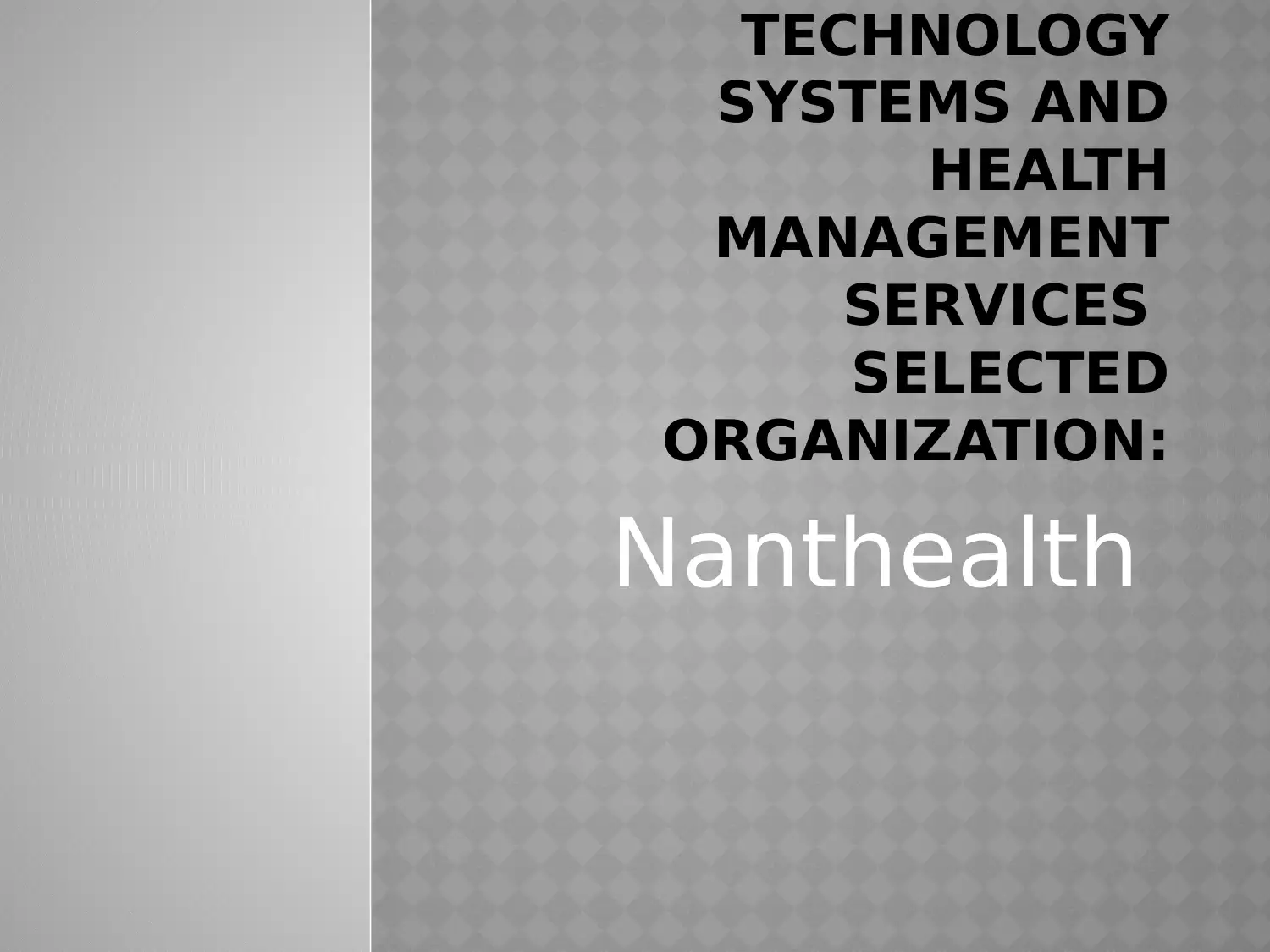
TECHNOLOGY
SYSTEMS AND
HEALTH
MANAGEMENT
SERVICES
SELECTED
ORGANIZATION:
Nanthealth
SYSTEMS AND
HEALTH
MANAGEMENT
SERVICES
SELECTED
ORGANIZATION:
Nanthealth
Paraphrase This Document
Need a fresh take? Get an instant paraphrase of this document with our AI Paraphraser
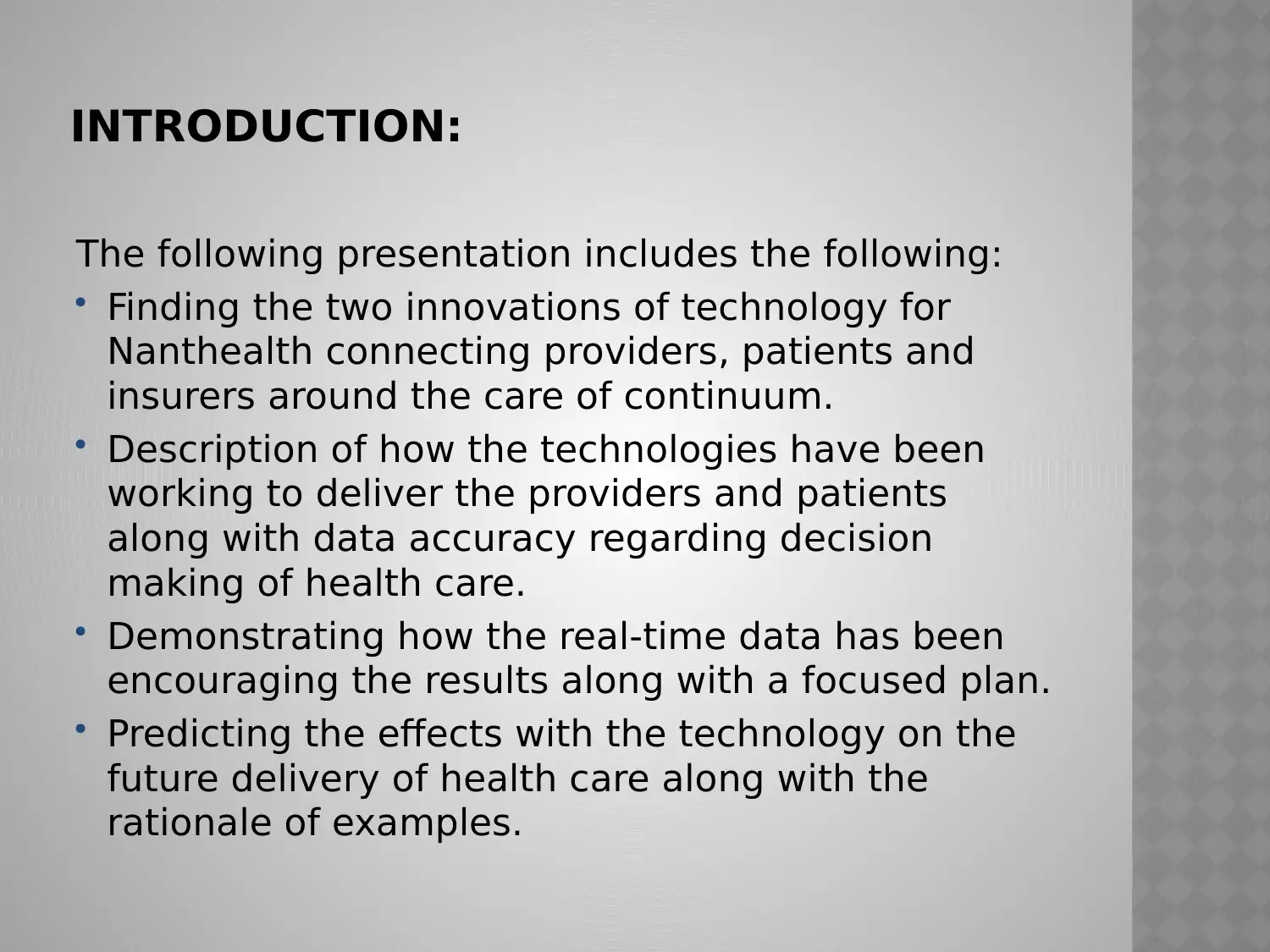
INTRODUCTION:
The following presentation includes the following:
Finding the two innovations of technology for
Nanthealth connecting providers, patients and
insurers around the care of continuum.
Description of how the technologies have been
working to deliver the providers and patients
along with data accuracy regarding decision
making of health care.
Demonstrating how the real-time data has been
encouraging the results along with a focused plan.
Predicting the effects with the technology on the
future delivery of health care along with the
rationale of examples.
The following presentation includes the following:
Finding the two innovations of technology for
Nanthealth connecting providers, patients and
insurers around the care of continuum.
Description of how the technologies have been
working to deliver the providers and patients
along with data accuracy regarding decision
making of health care.
Demonstrating how the real-time data has been
encouraging the results along with a focused plan.
Predicting the effects with the technology on the
future delivery of health care along with the
rationale of examples.
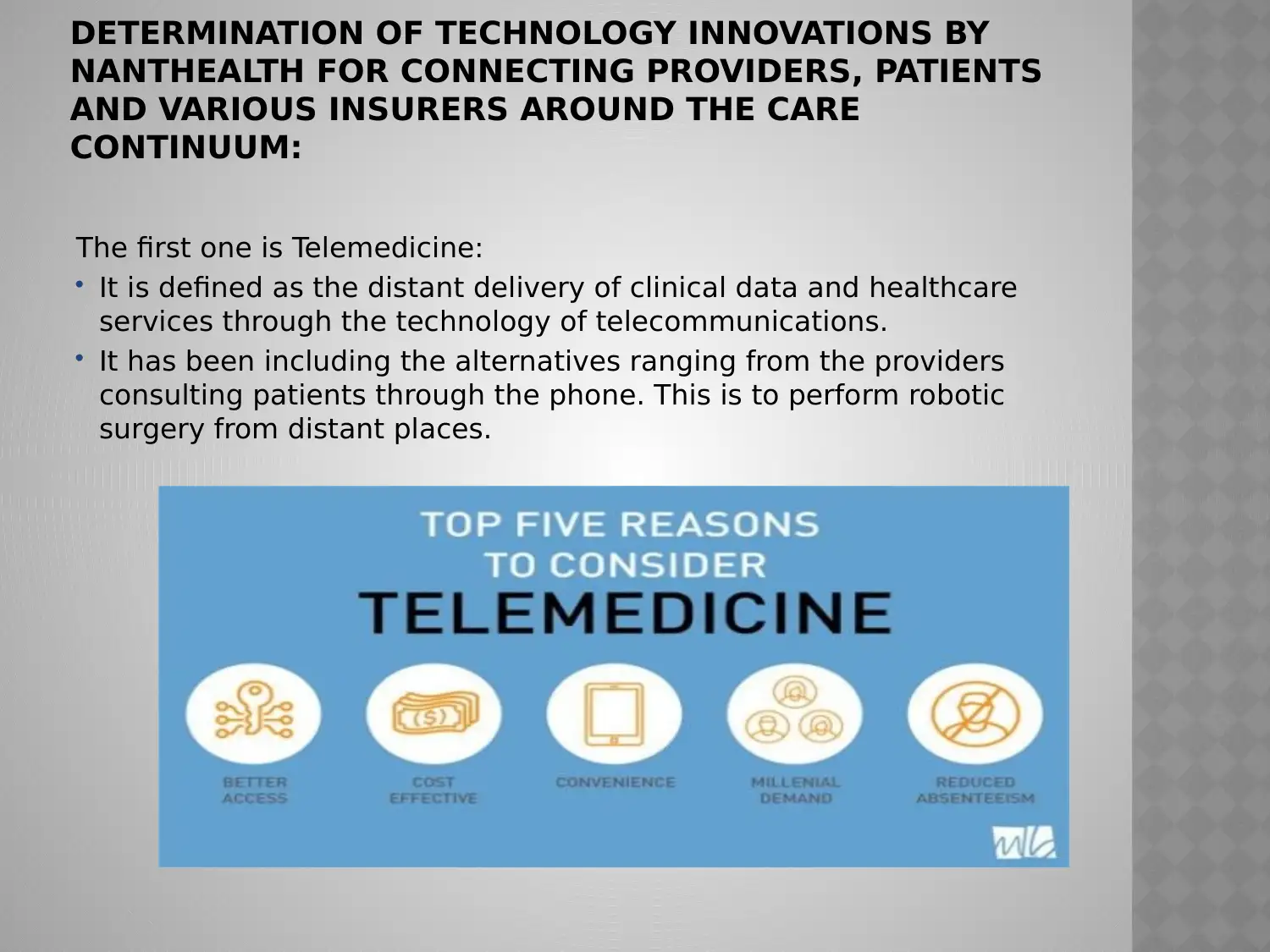
DETERMINATION OF TECHNOLOGY INNOVATIONS BY
NANTHEALTH FOR CONNECTING PROVIDERS, PATIENTS
AND VARIOUS INSURERS AROUND THE CARE
CONTINUUM:
The first one is Telemedicine:
It is defined as the distant delivery of clinical data and healthcare
services through the technology of telecommunications.
It has been including the alternatives ranging from the providers
consulting patients through the phone. This is to perform robotic
surgery from distant places.
NANTHEALTH FOR CONNECTING PROVIDERS, PATIENTS
AND VARIOUS INSURERS AROUND THE CARE
CONTINUUM:
The first one is Telemedicine:
It is defined as the distant delivery of clinical data and healthcare
services through the technology of telecommunications.
It has been including the alternatives ranging from the providers
consulting patients through the phone. This is to perform robotic
surgery from distant places.
⊘ This is a preview!⊘
Do you want full access?
Subscribe today to unlock all pages.

Trusted by 1+ million students worldwide
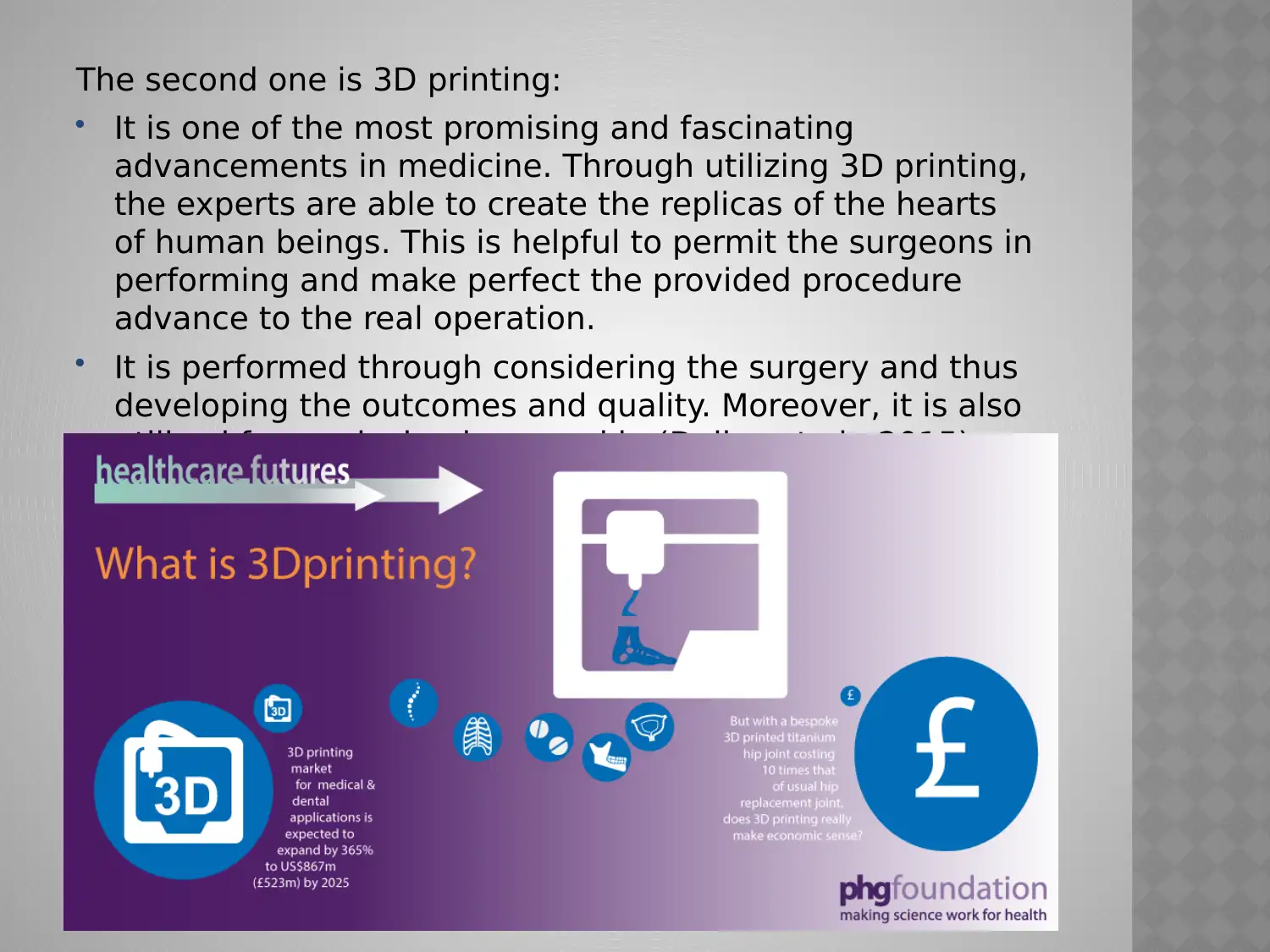
The second one is 3D printing:
It is one of the most promising and fascinating
advancements in medicine. Through utilizing 3D printing,
the experts are able to create the replicas of the hearts
of human beings. This is helpful to permit the surgeons in
performing and make perfect the provided procedure
advance to the real operation.
It is performed through considering the surgery and thus
developing the outcomes and quality. Moreover, it is also
utilized for producing human skin (Delias et al., 2015).
It is one of the most promising and fascinating
advancements in medicine. Through utilizing 3D printing,
the experts are able to create the replicas of the hearts
of human beings. This is helpful to permit the surgeons in
performing and make perfect the provided procedure
advance to the real operation.
It is performed through considering the surgery and thus
developing the outcomes and quality. Moreover, it is also
utilized for producing human skin (Delias et al., 2015).
Paraphrase This Document
Need a fresh take? Get an instant paraphrase of this document with our AI Paraphraser
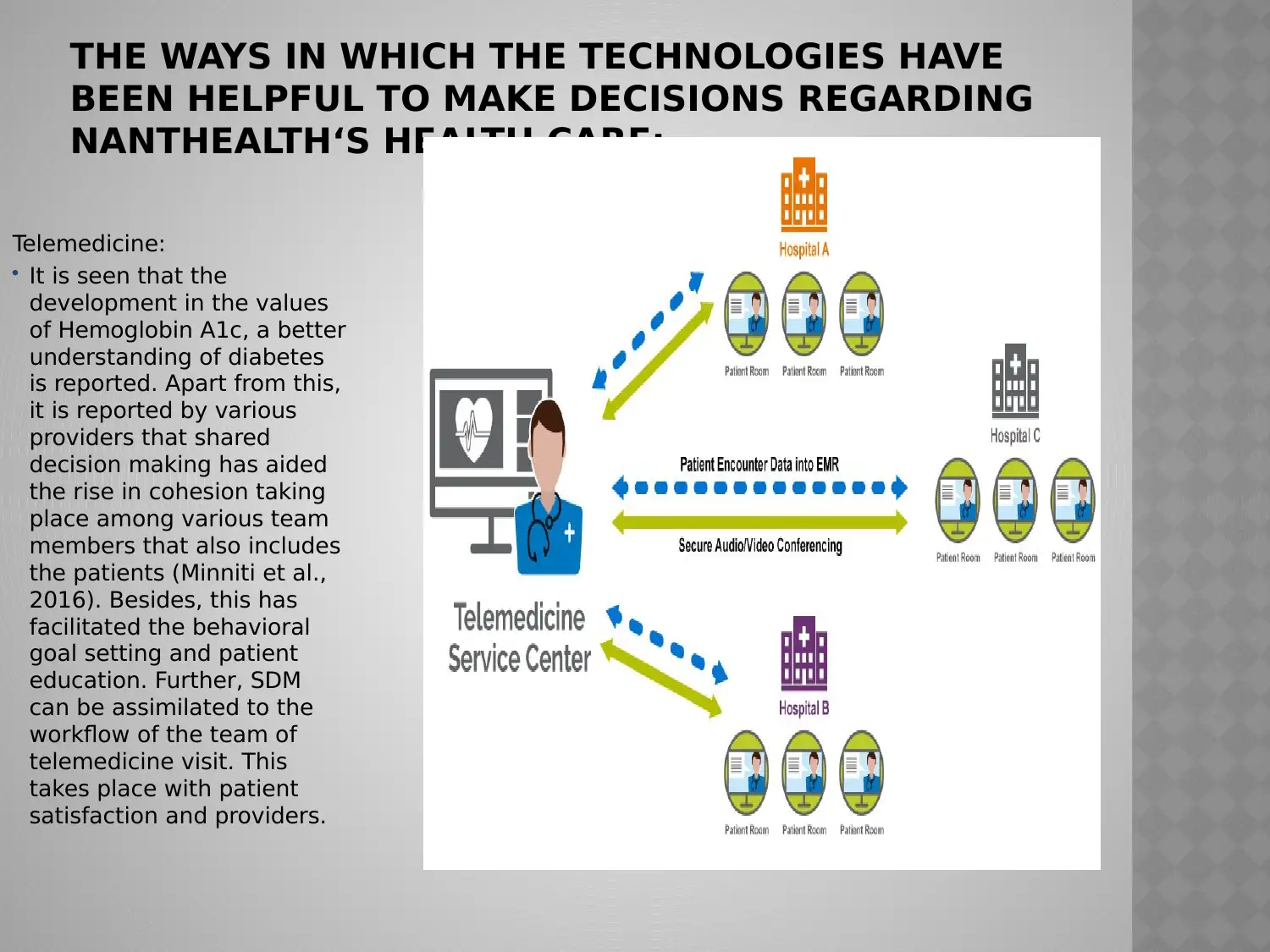
THE WAYS IN WHICH THE TECHNOLOGIES HAVE
BEEN HELPFUL TO MAKE DECISIONS REGARDING
NANTHEALTH‘S HEALTH CARE:
Telemedicine:
It is seen that the
development in the values
of Hemoglobin A1c, a better
understanding of diabetes
is reported. Apart from this,
it is reported by various
providers that shared
decision making has aided
the rise in cohesion taking
place among various team
members that also includes
the patients (Minniti et al.,
2016). Besides, this has
facilitated the behavioral
goal setting and patient
education. Further, SDM
can be assimilated to the
workflow of the team of
telemedicine visit. This
takes place with patient
satisfaction and providers.
BEEN HELPFUL TO MAKE DECISIONS REGARDING
NANTHEALTH‘S HEALTH CARE:
Telemedicine:
It is seen that the
development in the values
of Hemoglobin A1c, a better
understanding of diabetes
is reported. Apart from this,
it is reported by various
providers that shared
decision making has aided
the rise in cohesion taking
place among various team
members that also includes
the patients (Minniti et al.,
2016). Besides, this has
facilitated the behavioral
goal setting and patient
education. Further, SDM
can be assimilated to the
workflow of the team of
telemedicine visit. This
takes place with patient
satisfaction and providers.
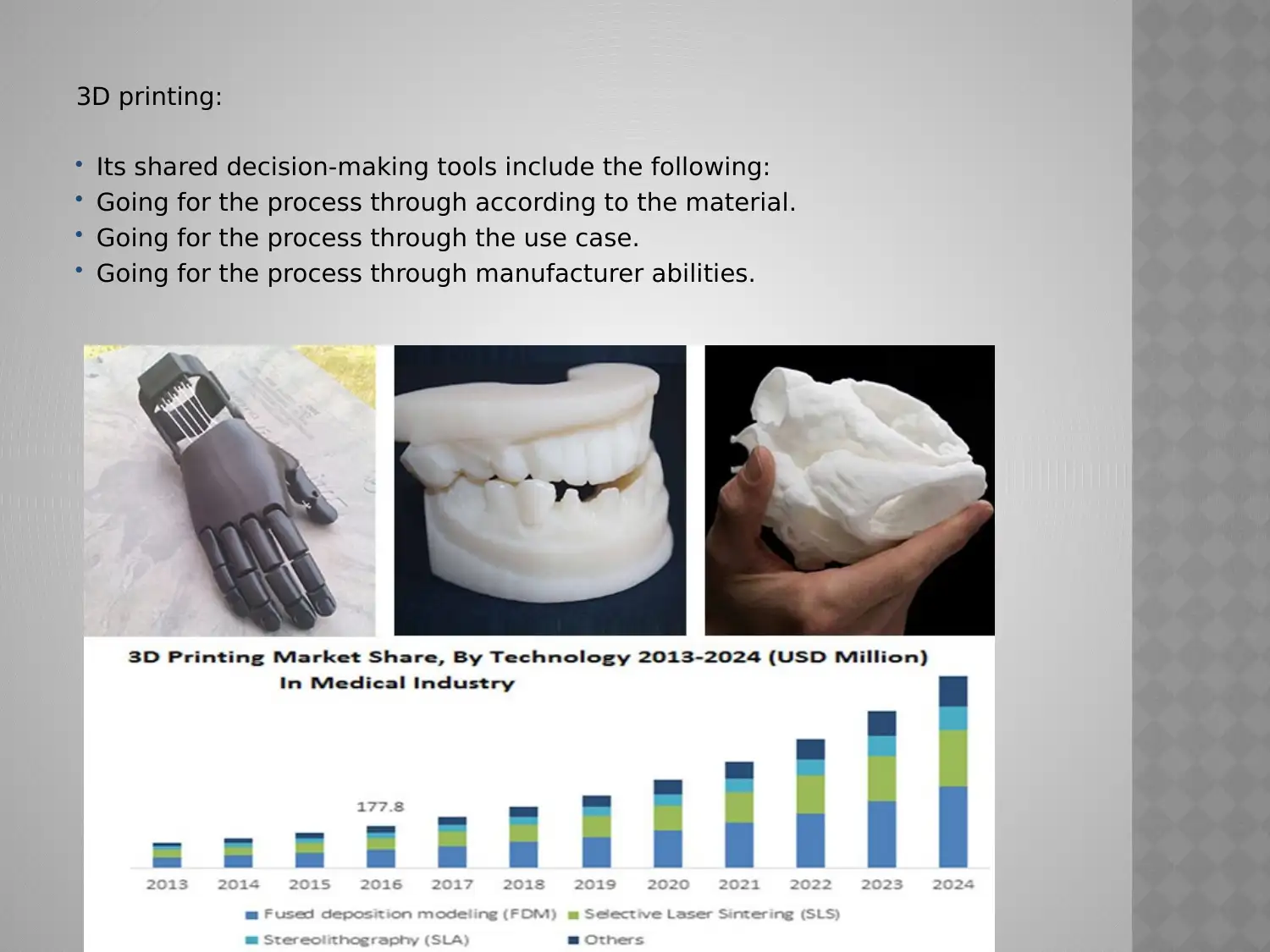
3D printing:
Its shared decision-making tools include the following:
Going for the process through according to the material.
Going for the process through the use case.
Going for the process through manufacturer abilities.
Its shared decision-making tools include the following:
Going for the process through according to the material.
Going for the process through the use case.
Going for the process through manufacturer abilities.
⊘ This is a preview!⊘
Do you want full access?
Subscribe today to unlock all pages.

Trusted by 1+ million students worldwide
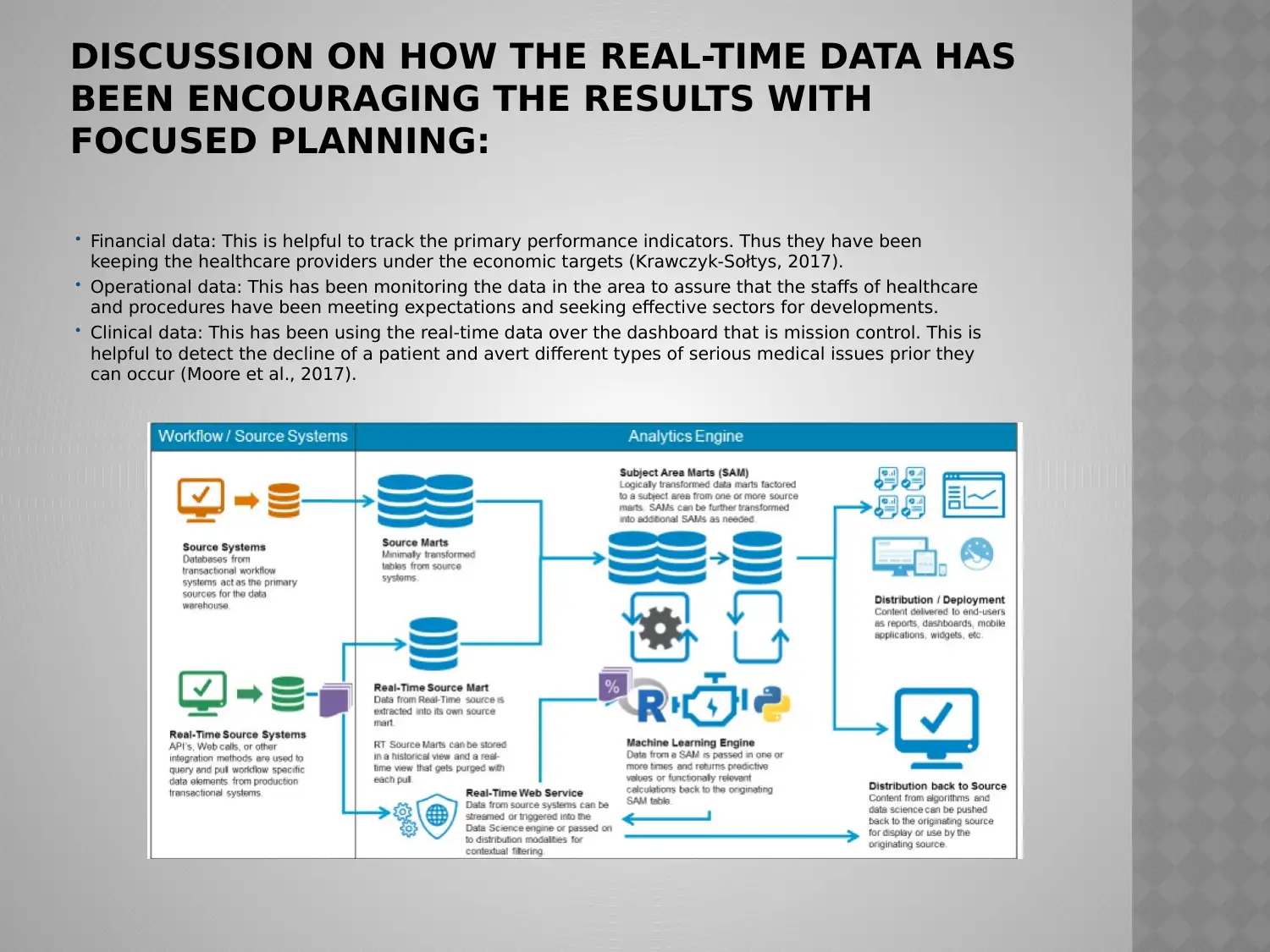
DISCUSSION ON HOW THE REAL-TIME DATA HAS
BEEN ENCOURAGING THE RESULTS WITH
FOCUSED PLANNING:
Financial data: This is helpful to track the primary performance indicators. Thus they have been
keeping the healthcare providers under the economic targets (Krawczyk-Sołtys, 2017).
Operational data: This has been monitoring the data in the area to assure that the staffs of healthcare
and procedures have been meeting expectations and seeking effective sectors for developments.
Clinical data: This has been using the real-time data over the dashboard that is mission control. This is
helpful to detect the decline of a patient and avert different types of serious medical issues prior they
can occur (Moore et al., 2017).
BEEN ENCOURAGING THE RESULTS WITH
FOCUSED PLANNING:
Financial data: This is helpful to track the primary performance indicators. Thus they have been
keeping the healthcare providers under the economic targets (Krawczyk-Sołtys, 2017).
Operational data: This has been monitoring the data in the area to assure that the staffs of healthcare
and procedures have been meeting expectations and seeking effective sectors for developments.
Clinical data: This has been using the real-time data over the dashboard that is mission control. This is
helpful to detect the decline of a patient and avert different types of serious medical issues prior they
can occur (Moore et al., 2017).
Paraphrase This Document
Need a fresh take? Get an instant paraphrase of this document with our AI Paraphraser
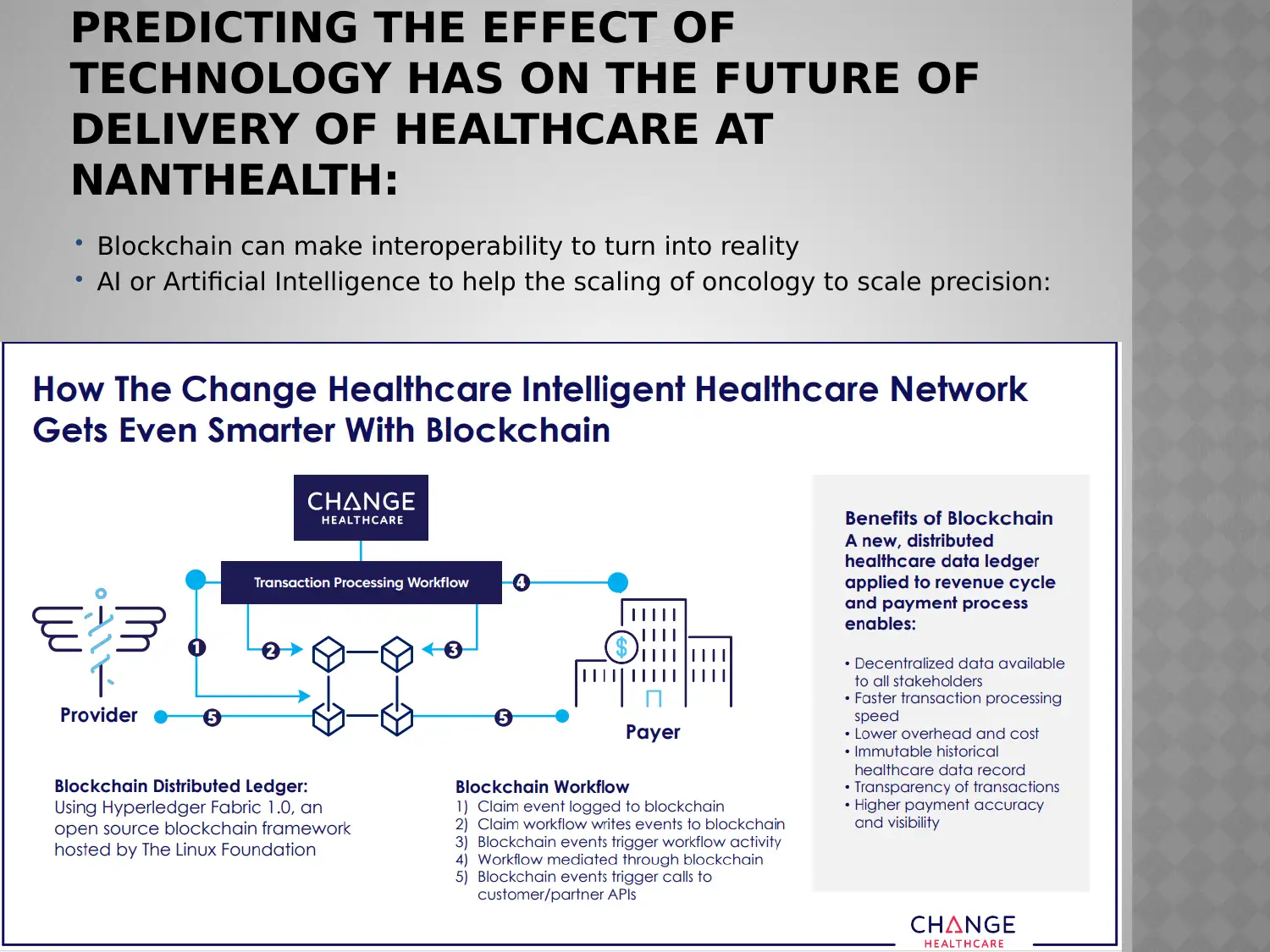
PREDICTING THE EFFECT OF
TECHNOLOGY HAS ON THE FUTURE OF
DELIVERY OF HEALTHCARE AT
NANTHEALTH:
Blockchain can make interoperability to turn into reality
AI or Artificial Intelligence to help the scaling of oncology to scale precision:
TECHNOLOGY HAS ON THE FUTURE OF
DELIVERY OF HEALTHCARE AT
NANTHEALTH:
Blockchain can make interoperability to turn into reality
AI or Artificial Intelligence to help the scaling of oncology to scale precision:
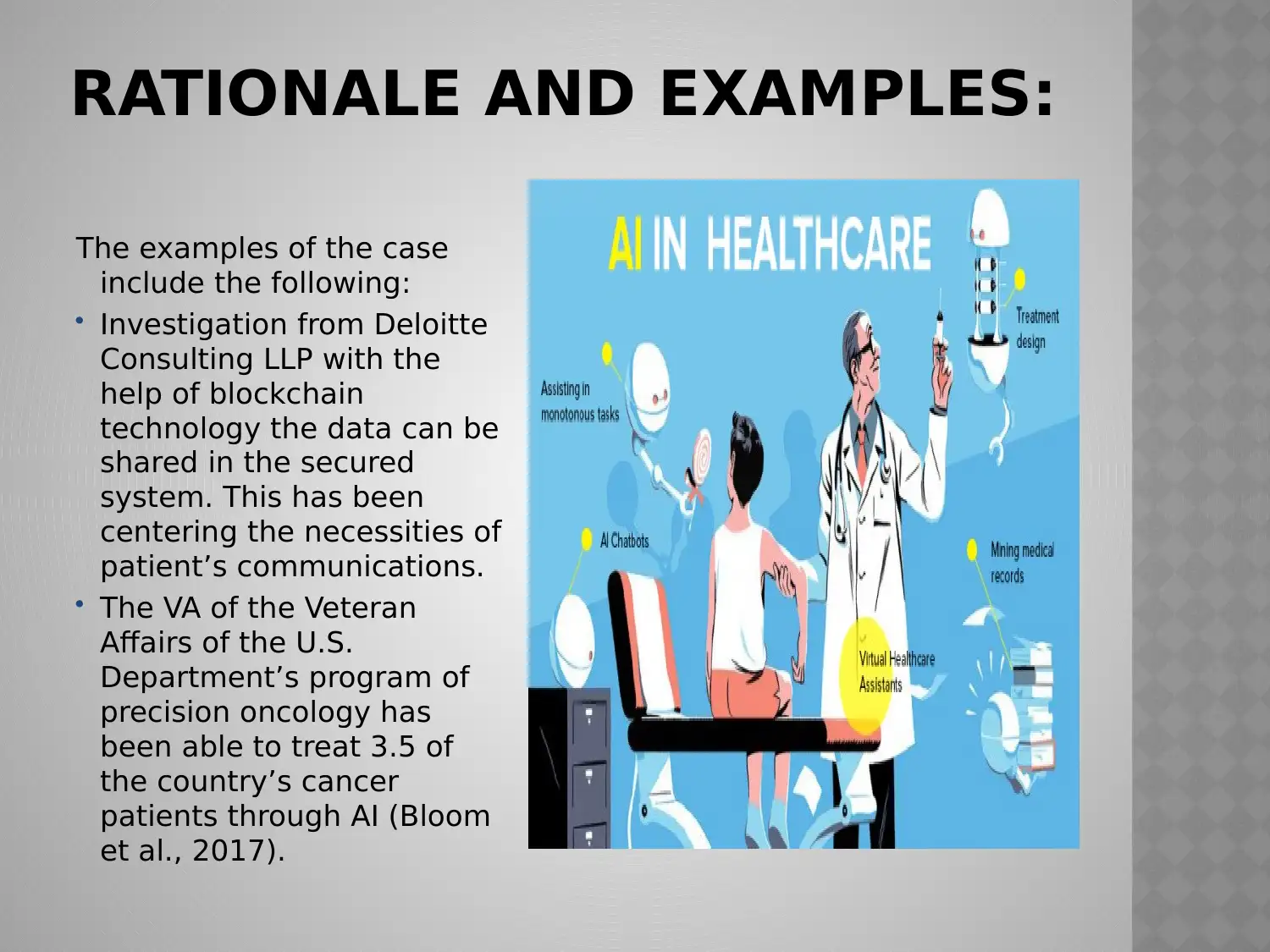
RATIONALE AND EXAMPLES:
The examples of the case
include the following:
Investigation from Deloitte
Consulting LLP with the
help of blockchain
technology the data can be
shared in the secured
system. This has been
centering the necessities of
patient’s communications.
The VA of the Veteran
Affairs of the U.S.
Department’s program of
precision oncology has
been able to treat 3.5 of
the country’s cancer
patients through AI (Bloom
et al., 2017).
The examples of the case
include the following:
Investigation from Deloitte
Consulting LLP with the
help of blockchain
technology the data can be
shared in the secured
system. This has been
centering the necessities of
patient’s communications.
The VA of the Veteran
Affairs of the U.S.
Department’s program of
precision oncology has
been able to treat 3.5 of
the country’s cancer
patients through AI (Bloom
et al., 2017).
⊘ This is a preview!⊘
Do you want full access?
Subscribe today to unlock all pages.

Trusted by 1+ million students worldwide
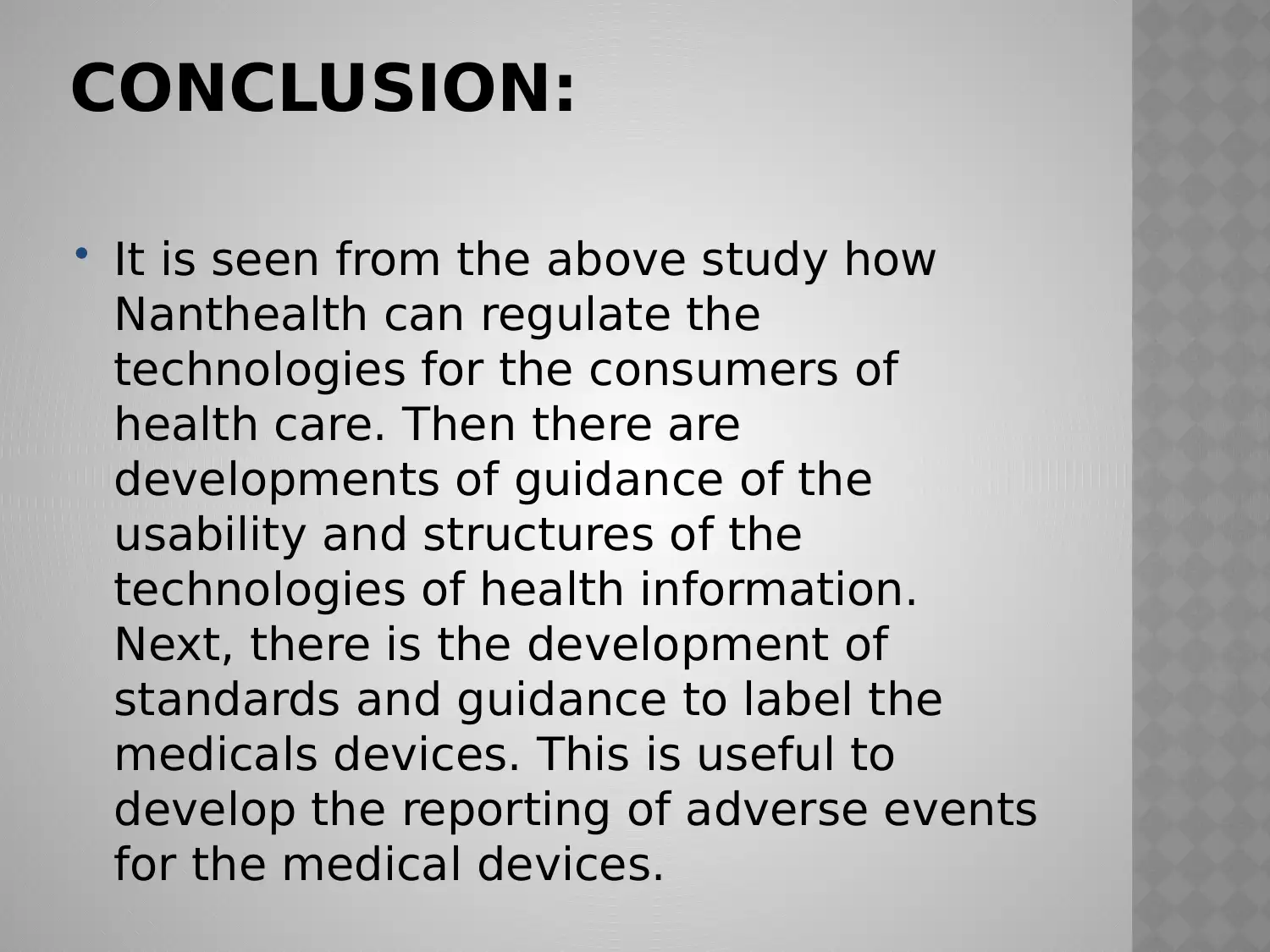
CONCLUSION:
It is seen from the above study how
Nanthealth can regulate the
technologies for the consumers of
health care. Then there are
developments of guidance of the
usability and structures of the
technologies of health information.
Next, there is the development of
standards and guidance to label the
medicals devices. This is useful to
develop the reporting of adverse events
for the medical devices.
It is seen from the above study how
Nanthealth can regulate the
technologies for the consumers of
health care. Then there are
developments of guidance of the
usability and structures of the
technologies of health information.
Next, there is the development of
standards and guidance to label the
medicals devices. This is useful to
develop the reporting of adverse events
for the medical devices.
Paraphrase This Document
Need a fresh take? Get an instant paraphrase of this document with our AI Paraphraser
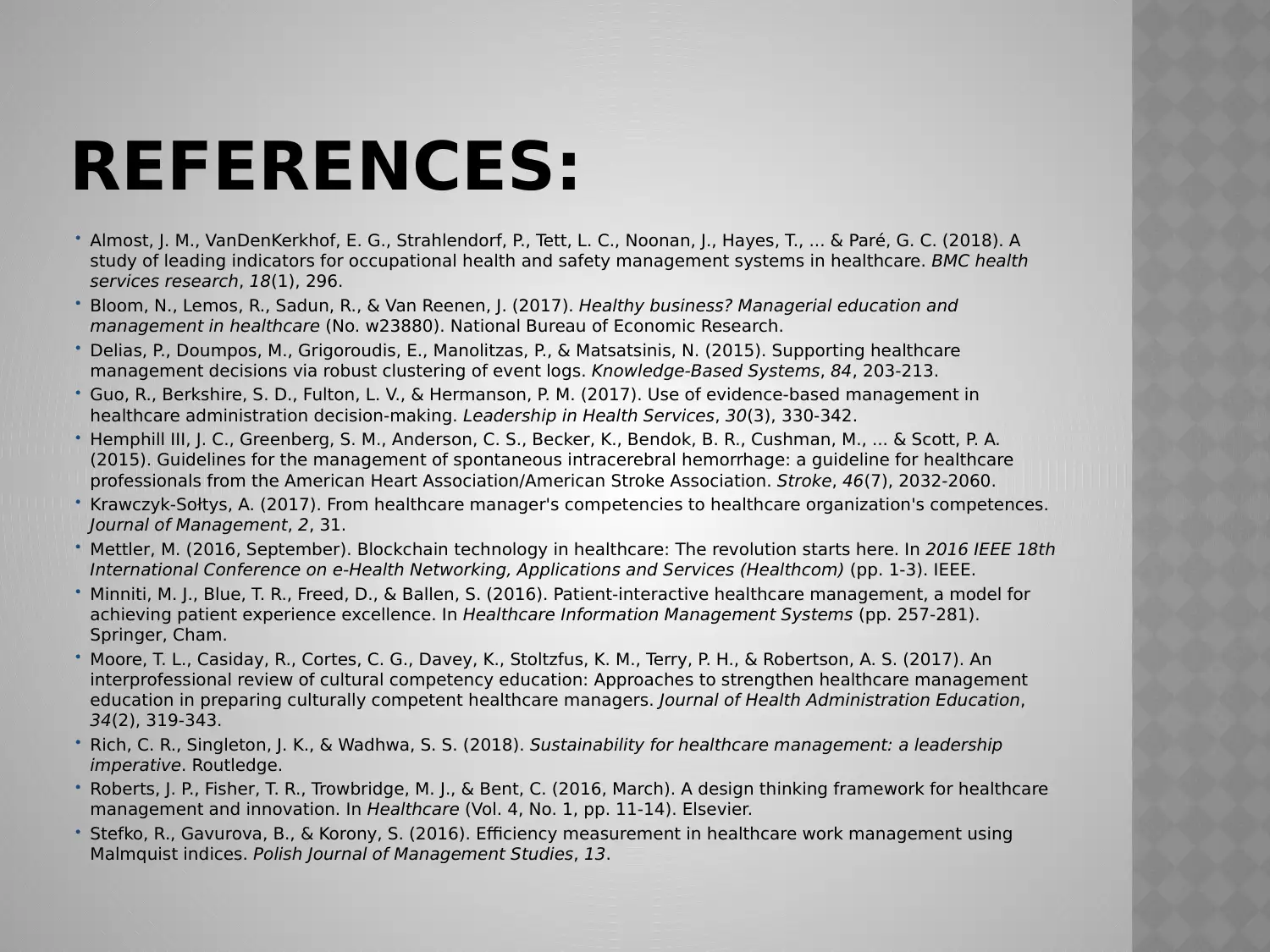
REFERENCES:
Almost, J. M., VanDenKerkhof, E. G., Strahlendorf, P., Tett, L. C., Noonan, J., Hayes, T., ... & Paré, G. C. (2018). A
study of leading indicators for occupational health and safety management systems in healthcare. BMC health
services research, 18(1), 296.
Bloom, N., Lemos, R., Sadun, R., & Van Reenen, J. (2017). Healthy business? Managerial education and
management in healthcare (No. w23880). National Bureau of Economic Research.
Delias, P., Doumpos, M., Grigoroudis, E., Manolitzas, P., & Matsatsinis, N. (2015). Supporting healthcare
management decisions via robust clustering of event logs. Knowledge-Based Systems, 84, 203-213.
Guo, R., Berkshire, S. D., Fulton, L. V., & Hermanson, P. M. (2017). Use of evidence-based management in
healthcare administration decision-making. Leadership in Health Services, 30(3), 330-342.
Hemphill III, J. C., Greenberg, S. M., Anderson, C. S., Becker, K., Bendok, B. R., Cushman, M., ... & Scott, P. A.
(2015). Guidelines for the management of spontaneous intracerebral hemorrhage: a guideline for healthcare
professionals from the American Heart Association/American Stroke Association. Stroke, 46(7), 2032-2060.
Krawczyk-Sołtys, A. (2017). From healthcare manager's competencies to healthcare organization's competences.
Journal of Management, 2, 31.
Mettler, M. (2016, September). Blockchain technology in healthcare: The revolution starts here. In 2016 IEEE 18th
International Conference on e-Health Networking, Applications and Services (Healthcom) (pp. 1-3). IEEE.
Minniti, M. J., Blue, T. R., Freed, D., & Ballen, S. (2016). Patient-interactive healthcare management, a model for
achieving patient experience excellence. In Healthcare Information Management Systems (pp. 257-281).
Springer, Cham.
Moore, T. L., Casiday, R., Cortes, C. G., Davey, K., Stoltzfus, K. M., Terry, P. H., & Robertson, A. S. (2017). An
interprofessional review of cultural competency education: Approaches to strengthen healthcare management
education in preparing culturally competent healthcare managers. Journal of Health Administration Education,
34(2), 319-343.
Rich, C. R., Singleton, J. K., & Wadhwa, S. S. (2018). Sustainability for healthcare management: a leadership
imperative. Routledge.
Roberts, J. P., Fisher, T. R., Trowbridge, M. J., & Bent, C. (2016, March). A design thinking framework for healthcare
management and innovation. In Healthcare (Vol. 4, No. 1, pp. 11-14). Elsevier.
Stefko, R., Gavurova, B., & Korony, S. (2016). Efficiency measurement in healthcare work management using
Malmquist indices. Polish Journal of Management Studies, 13.
Almost, J. M., VanDenKerkhof, E. G., Strahlendorf, P., Tett, L. C., Noonan, J., Hayes, T., ... & Paré, G. C. (2018). A
study of leading indicators for occupational health and safety management systems in healthcare. BMC health
services research, 18(1), 296.
Bloom, N., Lemos, R., Sadun, R., & Van Reenen, J. (2017). Healthy business? Managerial education and
management in healthcare (No. w23880). National Bureau of Economic Research.
Delias, P., Doumpos, M., Grigoroudis, E., Manolitzas, P., & Matsatsinis, N. (2015). Supporting healthcare
management decisions via robust clustering of event logs. Knowledge-Based Systems, 84, 203-213.
Guo, R., Berkshire, S. D., Fulton, L. V., & Hermanson, P. M. (2017). Use of evidence-based management in
healthcare administration decision-making. Leadership in Health Services, 30(3), 330-342.
Hemphill III, J. C., Greenberg, S. M., Anderson, C. S., Becker, K., Bendok, B. R., Cushman, M., ... & Scott, P. A.
(2015). Guidelines for the management of spontaneous intracerebral hemorrhage: a guideline for healthcare
professionals from the American Heart Association/American Stroke Association. Stroke, 46(7), 2032-2060.
Krawczyk-Sołtys, A. (2017). From healthcare manager's competencies to healthcare organization's competences.
Journal of Management, 2, 31.
Mettler, M. (2016, September). Blockchain technology in healthcare: The revolution starts here. In 2016 IEEE 18th
International Conference on e-Health Networking, Applications and Services (Healthcom) (pp. 1-3). IEEE.
Minniti, M. J., Blue, T. R., Freed, D., & Ballen, S. (2016). Patient-interactive healthcare management, a model for
achieving patient experience excellence. In Healthcare Information Management Systems (pp. 257-281).
Springer, Cham.
Moore, T. L., Casiday, R., Cortes, C. G., Davey, K., Stoltzfus, K. M., Terry, P. H., & Robertson, A. S. (2017). An
interprofessional review of cultural competency education: Approaches to strengthen healthcare management
education in preparing culturally competent healthcare managers. Journal of Health Administration Education,
34(2), 319-343.
Rich, C. R., Singleton, J. K., & Wadhwa, S. S. (2018). Sustainability for healthcare management: a leadership
imperative. Routledge.
Roberts, J. P., Fisher, T. R., Trowbridge, M. J., & Bent, C. (2016, March). A design thinking framework for healthcare
management and innovation. In Healthcare (Vol. 4, No. 1, pp. 11-14). Elsevier.
Stefko, R., Gavurova, B., & Korony, S. (2016). Efficiency measurement in healthcare work management using
Malmquist indices. Polish Journal of Management Studies, 13.

⊘ This is a preview!⊘
Do you want full access?
Subscribe today to unlock all pages.

Trusted by 1+ million students worldwide
1 out of 12
Related Documents
Your All-in-One AI-Powered Toolkit for Academic Success.
+13062052269
info@desklib.com
Available 24*7 on WhatsApp / Email
![[object Object]](/_next/static/media/star-bottom.7253800d.svg)
Unlock your academic potential
Copyright © 2020–2025 A2Z Services. All Rights Reserved. Developed and managed by ZUCOL.





